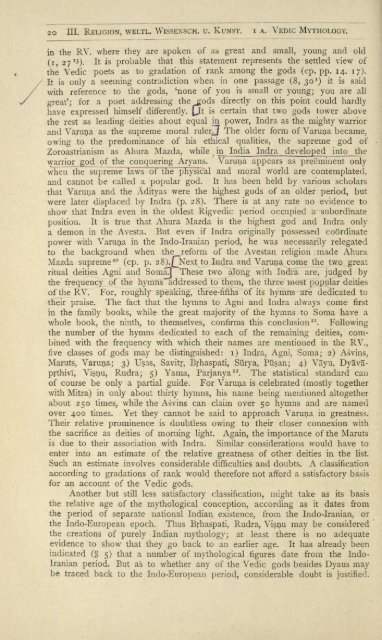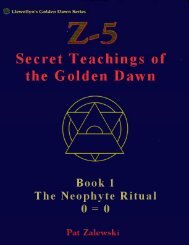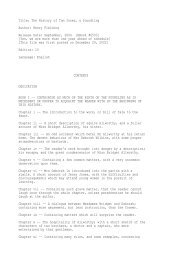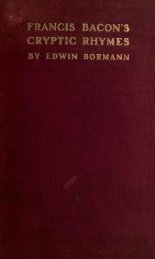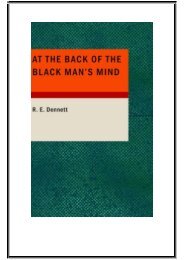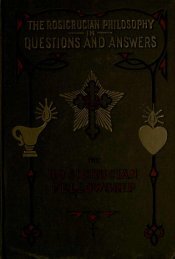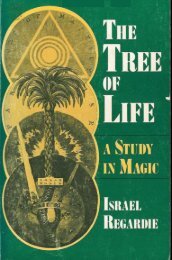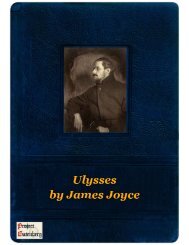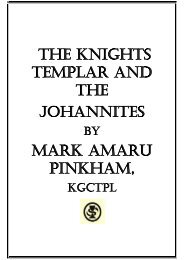download PDF version: 25.9MB - Global Grey
download PDF version: 25.9MB - Global Grey
download PDF version: 25.9MB - Global Grey
Create successful ePaper yourself
Turn your PDF publications into a flip-book with our unique Google optimized e-Paper software.
20 III. RELIGION, WELTL. WISSENSCH. u. KUNST. i A. VEDIC MYTHOLOGY.<br />
in the RY. where they are spoken of as great and small, young and old<br />
(i, 27 13 ). It is probable that this statement the Vedic<br />
represents the settled<br />
poets<br />
view of<br />
as to gradation of rank among the gods (cp. pp. 14. 17).<br />
It is only a seeming contradiction when in one passage (8, 30 l<br />
) it is said<br />
with reference to the gods, none of you is small or young; you<br />
are all<br />
great for a ; poet addressing the sjods directly on this point could hardly<br />
have expressed himself differently, pit is certain that two gods tower above<br />
the rest as leading deities about equal in power, Indra as the mighty warrior<br />
and Varuna as the supreme moral rulerTJ The older form of Varuna became,<br />
owing to the predominance of his ethical qualities, the supreme god of<br />
Zoroastrianism as Ahura Mazda, while in India Indra developed into the<br />
(<br />
\yarrior god of the conquering Aryans. Varuna appears as preeminent only<br />
when the supreme laws "ot the "pEysTcal and moral world are contemplated,<br />
and cannot be called a popular god. It has been held by various scholars<br />
that Varuna and the Adityas were the highest gods of an older period, but<br />
were later displaced by Indra (p. 28). There is at any rate no evidence to<br />
show that Indra even in the oldest Rigvedic period occupied a subordinate<br />
position.<br />
It is true that Ahura Mazda is the highest god and Indra only<br />
a demon in the Avesta. But even if Indra originally possessed coordinate<br />
power with Varuna in the Indo-Iranian period, he was necessarily relegated<br />
to the background when the reform of the Avestan religion made Ahura<br />
Mazda supreme 20<br />
(cp. p. 28).f/Next to Indra and Varuna come the two great<br />
ritual deities Agni and SornaTJ These two along with Indra are, judged by<br />
the frequency of the hymns addressed to them, the three most popular deities<br />
of the RV. For, roughly speaking, three-fifths of its hymns are dedicated to<br />
their praise. The fact that the hymns to Agni and Indra always come first<br />
in the family books, while the great majority of the hymns<br />
to Soma have a<br />
whole book, the ninth, to themselves, confirms this conclusion 21 . Following<br />
the number of the hymns dedicated to each of the remaining deities, com<br />
bined with the frequency with which their names are mentioned in the RV.,<br />
five classes of gods may be distinguished: i) Indra, Agni, Soma; 2) Asvins,<br />
Maruts, Varuna; 3) Usas, Savitr, Brhaspati, Surya, Piisan; 4) Vayu, Dyavaprthivl,<br />
Visnu, Rudra; 5) Yama, Parjanya 22 . The statistical standard can<br />
of course be only a partial guide. For Varuna is celebrated (mostly together<br />
with Mitra) in only about thirty hymns, his name being mentioned altogether<br />
about 250 times, while the Asvins can claim over 50 hymns and are named<br />
over 400 times. Yet they cannot be said to approach Varuna in greatness.<br />
Their relative prominence is doubtless owing to their closer connexion with<br />
the sacrifice as deities of morning light. Again, the importance of the Maruts<br />
is due to their association with Indra. Similar considerations would have to<br />
enter into an estimate of the relative greatness of other deities in the list.<br />
Such an estimate involves considerable difficulties and doubts. A classification<br />
according to gradations of rank would therefore not afford a satisfactory basis<br />
for an account of the Vedic gods.<br />
Another but still less satisfactory classification, might take as its basis<br />
the relative age of the mythological conception, according as it dates from<br />
the period of separate national Indian existence, from the Indo-Iranian, or<br />
the Indo-European epoch. Thus Brhaspati, Rudra, Visnu may be considered<br />
the creations of purely Indian mythology; at least there is no adequate<br />
evidence to show that they go back to an earlier age. It has already been<br />
indicated ( 5) that a number of mythological figures date from the Indo-<br />
Iranian period. But as to whether any of the Vedic gods besides Dyaus may<br />
be traced back to the Indo-European period, considerable doubt is justified.


